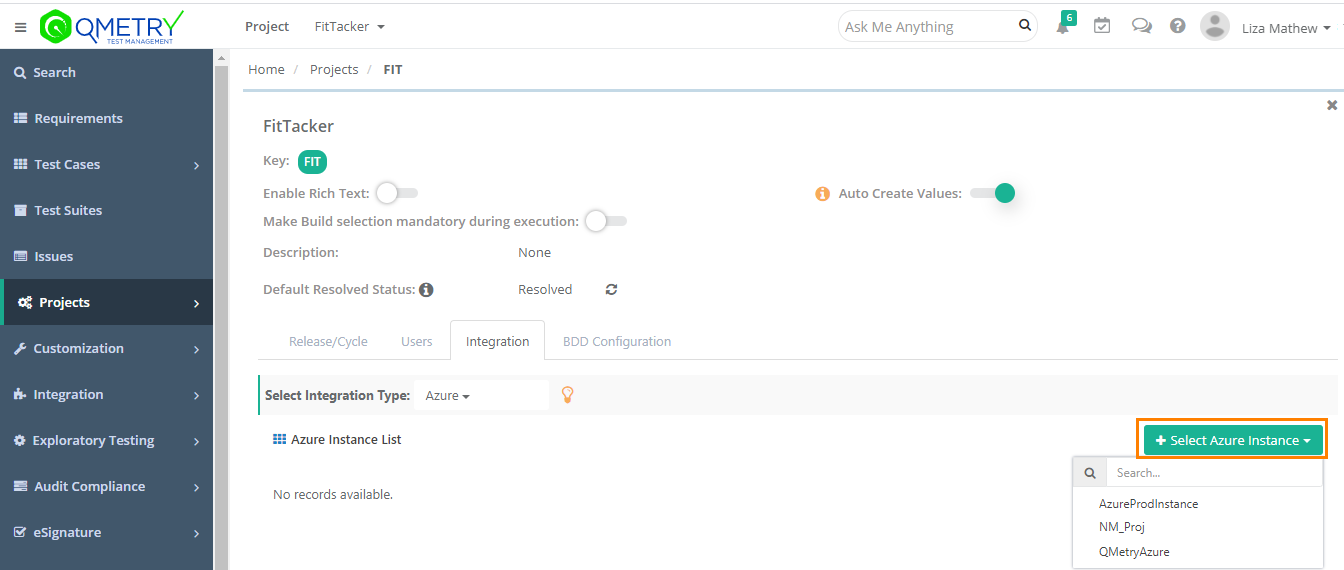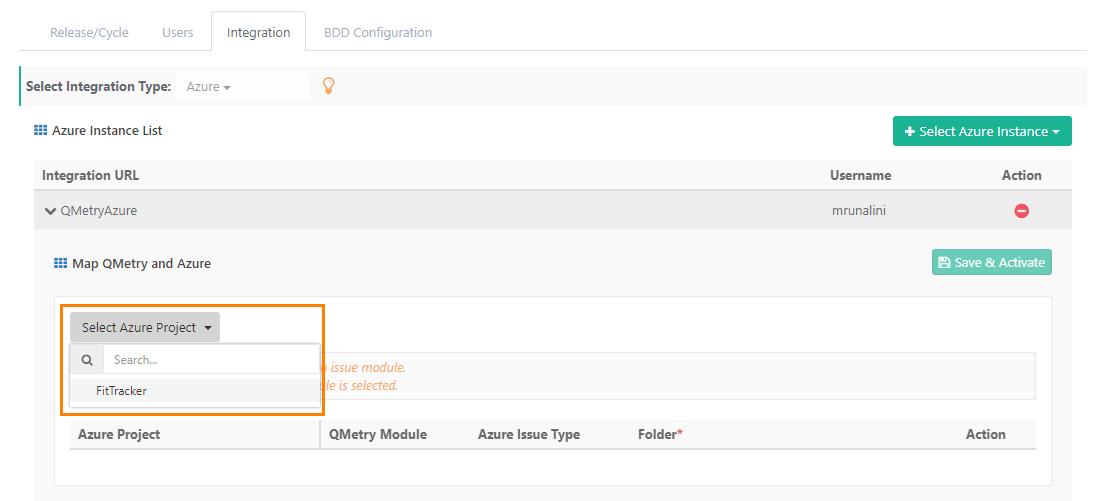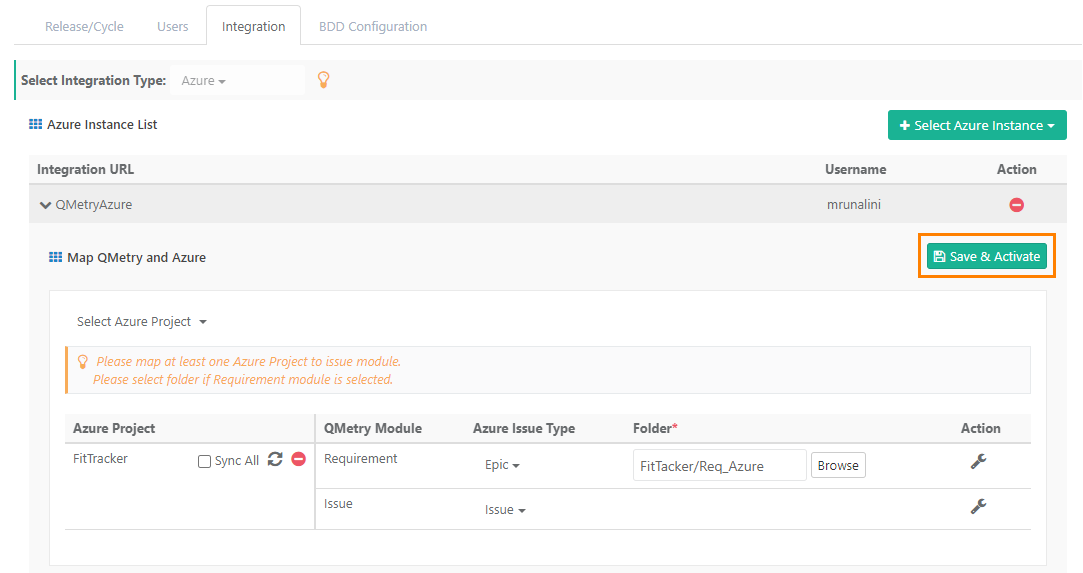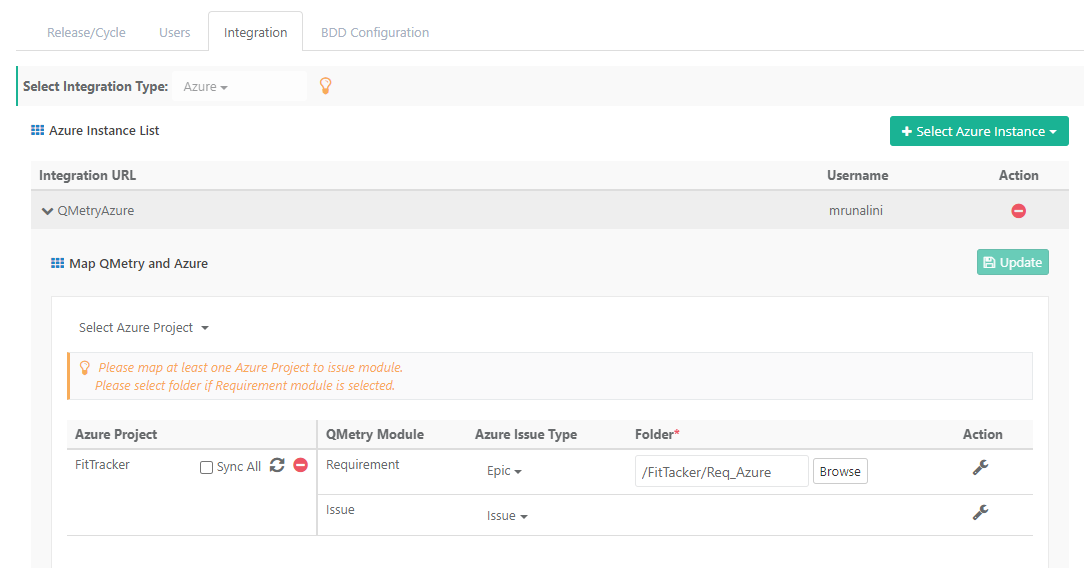...
These steps have to be performed in QMetry by Login as QMetry Project Admin :
Go to Projects > Project/Release/Cycle
Open the Project > Integration tab.
Select the Azure URL with which this QMetry project mapping has to be done.
Select the Azure project to configure with this QMetry Project.
Once the project is selected, select Issue Type <> QMetry Module associations. The issue type is a multi-select list. If the requirement is mapped, select the folder to import requirements.
Click on Save and Activate.
...
Map multiple Azure projects from a single Azure instance with one QMetry project
QMetry allows multiple Azure projects to be configured with one QMetry project. Below are the steps for the same :
Go to Projects > Project/Release/Cycle
Open the Project > Azure Integration tab.
Select the Azure URL with which this QMetry project configuration has to be done.
Select the Azure project to configure with QMetry Project.
Map Azure Issue Types to QMetry Modules.
...
Map Azure Issue types to QMetry modules
Once the project is selected, if you are managing your project requirements as Azure epics, you should select the Issue Types "Epic" to be associated with the Requirement module. Selection of Issue Type is a multi-select filter, which allows you to select multiple issue types and map with the Requirements module. Selection of the folder where the imported issues will be created is mandatory. The first time sync will import all the issues to the selected folder. These issues can, later on, be moved to other folders in QMetry where any changes done to the issues will be synced. However, all the new stories and epics that are not part of QMetry will be synced into the selected folder.
To map issue types like bugs or tasks to the Issue module, users can select the Issue Types associated with the Issue module. This is a multi-select filter. The issue types that are mapped with the Requirement module can not be mapped with the Issue module and vice-versa. The issues that would be imported and synced with QMetry, would be visible in the Issue module with the external key indicating the Azure Issue Key.
Click on Save and Activate/update once the configuration is done. ("Update" if Azure integration was already Saved and Activated for the QMetry project.)
Go to Integrations and check the syncing of Requirement, Issue and Metadata is completed.
...
Map multiple Azure projects from multiple Azure instances with one QMetry project
QMetry allows multiple Azure instances to be configured with one QMetry project. Below are the steps for the same:
Go to Projects > Project/Release/Cycle
Open the Project > Integration tab.
Select the Azure instance with which this QMetry project configuration has to be done.
Configure the projects > Save and Activate the Integration.
Once the project is selected, select Issue Type <> QMetry Module associations. The issue type is a multi-select list. If the requirement is mapped, select a folder to import requirements.
Select another Azure instance from the Azure Instance list.
...
Configure the projects > Save and Activate the integration.
...
Once the Project is selected, select Issue Type <> QMetry Module associations. The issue type is a multi-select list. If the requirement is mapped, select a folder to import requirements.
This way you can integrate multiple Azure instances with QMetry Project.
...
Note: In case QMetry does not display the Azure field in the configuration screen - "Sync" project data to configure the field.
Configure custom fields for Requirements and Issues.
Sync Azure data to QMetry. For example, newly created custom fields, etc.
A. Sync All: It will sync all issues irrespective of their updated-date.
B. Sync: It will sync only those issue values which are recently updated in Azure based on their updated-date.
You can sync the mapped Azure custom fields in the QMetry Insight module for Visual Reports and Advanced Query Reports. Read more about Sync fields to Reports.
...
Note: At least one of the Azure Project should be integrated with the Issue Module. Once Azure is integrated with the QMetry project, the internal issue module will be disappeared from the QMetry project.
...
The Integration tab gives you a quick idea of the status of Azure and QMetry project integration.
Steps
Expand Integration on the sidebar menu and select Azure Integrations. There are two tabs on the screen: Integration and Azure Scheduler Status.
Open the Integration tab.
...




